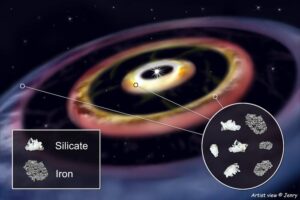
I’ve said it before, and I suspect I’ll say it again: we don’t have a detailed understanding of how planets form. We have ideas, but our observations keep now quite matching what we expect. To understand what is actually going on, we simply need to study more and more systems, with each new solar system revealing a single frame in the movie of a planetary system’s birth and life.
Admittedly, this is a bit like piecing together the plot of a movie after finding the movie stills scattered across a park: you have to hope you are putting them in the right order, and there is always the possibility you’re working with stills from more than one movie.
In the latest still that scientists have found, researchers using the Very Large Telescope Interferometer have observed a set of three concentric rings around the star HD 144432, which is about 500 light-years away. The innermost of these rings is at about the distance of Mercury from its star, and the outer ring is at about the distance of Jupiter from its star, with the middle rings at Mars distance. The two gaps between the three rings represent the location of planets, and it’s expected this system has at least those two planets. There is always the potential for a more inner world as well as other outer worlds to also exist.
This work is reported in the journal Astronomy and Astrophysics and was led by József Varga.
While our current technology can’t make out details of those potential worlds, we can effectively study the dust rings, including the composition of those rings. Initial studies reveal what appears to be the presence of iron dust in these rings. If confirmed, then we are seeing a disk that has the same kind of material needed to form worlds like the inner worlds in our solar system. According to study co-author Roy van Boekel, “We think that the HD 144432 disk may be very similar to the early solar system that provided lots of iron to the rocky planets we know today.”
HD 144432 is just one of many stars that this team will be studying. Van Boekal explains, “We still have a few promising candidates waiting for the VLTI to take a closer look at.”
I, for one, can’t wait to see what they find.
